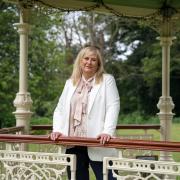Meet a Leeds jewellery designer who discovered his talent at the bottom of the garden, reports Jo Haywood
You wouldn’t normally expect to find a luxury jewellery designer at an address known locally, and with little affection, as ‘Bin Alley’. But then Andrew Geoghegan is used to humble surroundings. He did, after all, begin his stellar career in a garden shed.
The award-winning accessory artist, whose contemporary, sculptural designs are sold through 60 retailers nationwide, seems comfortable and at peace in his chaotic Chapel Allerton office, which is accessed through a tatty green door in a narrow alleyway that is indeed peppered with bins.
His calm demeanour can partly be explained by his love of meditation, but it could also be argued that even the most chaotic office would bring a contented smile to your face after four years in a 10ft by 10ft shed at the bottom of your parents’ garden.
But how did he end up in the shed? And where did his creative ambitions spring from in the first place?
‘I was always a bit of an inventor, solving problems and making things,’ he explained. ‘I worked in 2D at first, painting and drawing as most children do, but then when I was about six my dad let me use his workbench in the garage.
‘I have to admit that his hammers and saws were very appealing.’ Andrew was encouraged by his art teacher at Leeds Grammar School and, when he was finally allowed access to fire and anvils, began sculpting in metal.
‘I loved the way I could control the material,’ he said. ‘And I loved the scale and permanence of the pieces I could create.’
After completing a foundation course at Jacob Kramer (now Leeds College of Art and Design), he took a degree in 3D design at Preston, specialising in tableware and silversmithing. Jewellery was not on his radar until he began his dissertation on mixing materials and discovered the artistic pleasures of working with silver and diamonds.
He bagged himself an apprenticeship with a jeweller in Manchester, bought himself a car and moved into a new place. Everything went swimmingly – for three weeks.
‘I was cocky, arrogant and impatient,’ said Andrew, with a wry smile. ‘Basically, I was 21 and thought I knew everything. In fact, I knew nothing and was soon found out. My new life was over before it had begun and I was forced to move back to Leeds to live with my parents.’
Desperate to get their son back on his chosen career path, despite their own misgivings, his parents bought him a shed to work in.
‘I started creating my own pieces and honing my skills,’ he said. ‘I was unfettered by classical design methods because I hadn’t been trained in them. That forced me to experiment and create new ways of solving design problems. I basically had to invent my own ways of doing things.’
The pieces he created were naive at first, but he soon developed his own contemporary, innovative style, catching the eye of Argent in Leeds’ Thorntons Arcade, the first retailer to sell his rings.
‘That gave me an enormous confidence boost and made it feel more like a career and less like a hobby,’ said Andrew. ‘And mum and dad were thrilled because it meant I could pay them back for the shed.’
A decade on, he is a well-established jewellery designer with a team of exceptional craftspeople transforming his chic yet fresh creations into elegant occasion rings and chi-chi cocktail pieces. ‘Each takes seemingly endless hours to resolve because, for me, it’s not just about the surface you see,’ he explained. ‘I insist every aspect is perfect. Every ring is a micro-sculpture to me.’
His best ideas come to him when he’s calm and he finds that meditation helps keep his workaday thoughts at bay, allowing his creative ideas to flow through. Once a piece is established on screen using computer-aided design technology, a resin version is made, tweaked and remade in wax before a master cast is created.
Add in journeys to the assay office for stamping and finishing by numerous craftspeople and the process from meditative thought to final product can be a long one.
‘We can turn a job around in two weeks if it’s an emergency,’ said Andrew. ‘But that is certainly not the norm. It usually takes considerably longer, more a matter of months than weeks and, occasionally, up to a year.’
He’s a busy man, much in demand for ‘meet the designer’ events these days, but in his fleeting moments of downtime does he ever find himself missing his shed?
‘A little,’ he said, with a laugh. ‘We’re actually hoping to revisit it for some promotional material – if the new owners of my parents’ old house will let us. And even if they don’t, I’m still glad it’s there. That shed completely changed my life.’


























